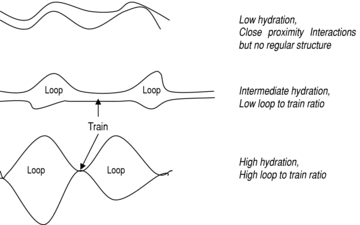Gluten HMM subunits importance (update 20-01-2020)
Extract from the study: The structure and properties of gluten
“…..omissis. One group of gluten proteins, the HMM subunits of glutenin, is particularly important in conferring high levels of elasticity (i.e. dough strength). These proteins are present in HMM polymers that are stabilized by disulphide bonds and are considered to form the ‘elastic backbone’ of gluten. However, the glutamine-rich repetitive sequences that comprise the central parts of the HMM subunits also form extensive arrays of interchain hydrogen bonds that may contribute to the elastic properties via a ‘loop and train*’ mechanism. Genetic engineering can be used to manipulate the amount and composition of the HMM subunits, leading to either increased dough strength or to more drastic changes in gluten structure and properties.
….omissis. These properties are usually described as viscoelasticity, with the balance between the extensibility and elasticity determining the end use quality. For example, highly elastic (‘strong’) doughs are required for breadmaking but more extensible doughs are required for making cakes and biscuits. Omisdsis….The grain proteins determine the viscoelastic properties of dough, in particular, the storage proteins that form a network in the dough called gluten (Schofield 1994). Consequently, the gluten proteins have been widely stud ied over a period in excess of 250 year, in order to determine their structures and properties and to provide a basis for manipulating and improving end use quality.
*

…omissis. As a result of the formation of a protein matrix, individual cells of wheat flour contain networks of gluten proteins, which are brought together during dough mix ing. The precise changes that occur in the dough during mixing are still not completely understood, but an increase in dough stiffness occurs that is generally considered to result from ‘optimization’ of protein–protein interactions within the gluten network. In molecular terms, this ‘optimization’ may include some exchange of disulphide bonds as mixing in air, oxygen and nitrogen result in different effects on the sulphydryl and disulphide contents of dough (Tsen & Bushuk 1963; Mecham & Knapp 1966).
I pro e i contro del glutine debole (Oriana Porfiri)
“I frumenti “alternativi” idonei per la pastificazione sono il farro dicocco, il grano khorasan o Triticum turanicum e popolazioni locali di grano duro come le saragolle, i grani antichi siciliani e vecchie varietà come il Senatore Cappelli. Questi frumenti sono stati “scelti” dagli agricoltori nel corso dei secoli per la loro adattabilità ambientale e la resa produttiva. La selezione in funzione della qualità di trasformazione (qualità tecnologica) è storia recente, degli ultimi 40-50 anni, nei quali la selezione operata dai costitutori vegetali è andata in direzione di aumentare il contenuto proteico e la quantità di glutine, accrescere la tenacità del glutine, ridurre il contenuto di amido, elevare la resa molitoria. Pertanto, nell’ambito dei grani “alternativi” è frequente individuare varietà con una quantità di glutine estratto più bassa rispetto a quelle moderne e, soprattutto, di scarsa tenacità (struttura del glutine più debole), di facile scomposizione, quindi più digeribile.
La pasta fatta con queste varietà di frumento
La pasta fatta con queste varietà di frumento hanno il pregio di essere adatte a coloro che soffrono di gluten sensitivity (sensibilità al glutine non celiaca) o vogliono mangiare “leggero”, ma per essere di qualità e avere tenuta alla cottura ha bisogno di un processo di pastificazione particolare. Tutto deve essere più lento: l’impasto, l’estrusione e l’essicazione. Inoltre, è impossibile stabilire una ricetta di lavorazione standardizzabile e buona per tutti: ogni prodotto, ogni raccolto, ogni località di provenienza della materia prima richiedono un aggiustamento dei parametri. Questi grani hanno molta variabilità e il pastificio deve costantemente correggere il tiro a misura delle caratteristiche qualitativo/tecnologiche, della quantità di proteine e di glutine dei grani di quell’anno. Sulla qualità della pasta influisce anche un terzo parametro, la quantità di amido presente, in particolare la frazione “resistente”, che è quella non digeribile e che ha un comportamento simile alle fibre, quindi contribuisce ad abbassare l’indice glicemico della pasta.”
a cura di Oriana Porfiri
agronoma ed esperta di cereli
Fonte: Notizie Pasta. Grani siciliani, pasta integrale, glutine debole e micotossine: 4 dilemmi affrontati con gli esperti 23 Ago. 2019, 01:00 | a cura di Gambero Rosso
